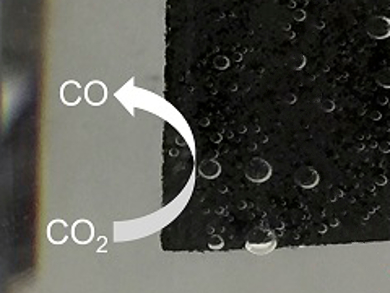Carbon dioxide, a greenhouse gas contributing to global warming, has become a popular research subject. Reducing CO2 into non-harmful derivatives for use as fuel is of particular interest, especially in terms of applying renewable energy such as solar or wind power to such reduction processes. Due to their low cost, large surface area, and high electrical conductivity, carbon nanomaterials are being widely used as electrocatalysts for the electrocatalytic reduction of CO2.
Rose Amal and colleagues, University of New South Wales, Sydney, Australia, have developed a CO2 reduction electrocatalyst by covalently attaching graphitic carbon nitride (g-C3N4) onto multiwall carbon nanotubes (MWCNTs). The g-C3N4/MWCNTs composite was prepared using cheap starting materials in an easy two-step approach of co-precipitation followed by polycondensation. Transmission electron microscopy (TEM) images showed that the MWCNTs were well integrated into the g-C3N4 material, which formed a layered structure.
Employing the composite as an electrocatalyst showed that it was stable for the selective reduction of CO2 to CO. The Faradaic efficiency of the process reached a maximum 60 % with 0.75 V applied potential. Notably, g-C3N4 or MWCNTs as individual electrocatalysts have negligible catalytic performance. The researchers attribute the high catalytic activity of the composite to its active nitrogen-carbon sites, an enlarged Brunauer-Emmett-Teller surface in comparison to the individual materials, as well as improved conductivity.
- Highly Selective and Stable Reduction of CO2 to CO by a Graphitic Carbon Nitride/Carbon Nanotube Composite Electrocatalyst,
Xunyu Lu, Tze Hao Tan, Yun Hau Ng, Rose Amal,
Chem. Eur. J. 2016.
DOI: 10.1002/chem.201601674



